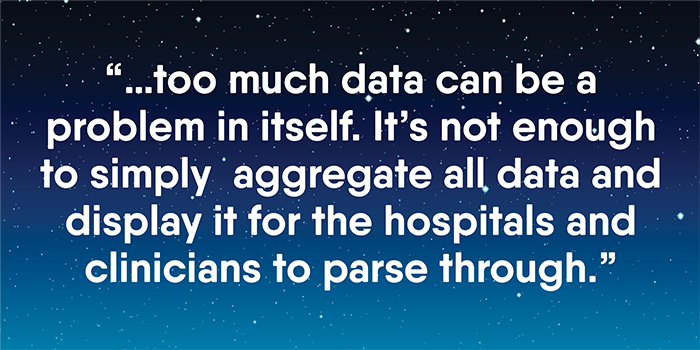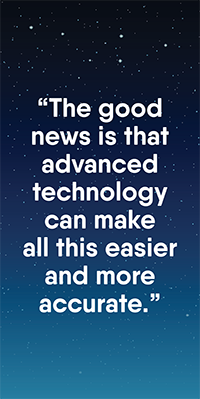Kunal Agarwal
The Healthiverse and Hospitals – Battling Medication History Misinformation
This blog is part of a series introducing the concept of the Healthiverse, explaining why it’s essential to eliminate the siloes between care team members, and exploring the benefits that a more united healthcare universe can deliver to different key stakeholders in the industry.
One of the first steps for providing care in a hospital is getting an accurate medication history. While it might sound simple to the uninitiated, clinicians and patients alike can attest that it is fraught with inconsistencies, missing information, and errors. The process can be challenging because the clinician has to look for information from pharmacy benefit managers, call pharmacies and healthcare providers, query health information exchanges, and interview the patient and family members.
For the patient, this process may seem both invasive and frustrating. Particularly if the patient is in pain or under duress, discussing every pill and prescription may seem like an unnecessary step that delays their care.
For a family member, it can seem like a frightening test with enormous ramifications for failure. They’re effectively forced to try to remember every medication that a loved one takes, its dose, and how frequently they take it, with wrong guesses potentially leading to negative drug and allergy interactions that can put the patient’s health at risk.
But while gathering and documenting medication histories can be time-intensive and difficult, it’s essential for the effective delivery of care.
Playing the Medication History Guessing Game
The medication reconciliation process generally follows these steps:
1. Attempting to gather an accurate medication history from pharmacy benefit managers, pharmacies, EMS staff and other providers, a family member, or the patient
2. Verifying the information with the patient to ensure that they are taking medications as prescribed
3. Documenting and resolving any changes or differences so the history reflects what medications the patient is actually taking
However, the idea that following these three steps will generate an accurate medication reconciliation is somewhat divorced from reality. In practice, it doesn’t always go smoothly or paint the full picture.
There are a number of reasons for discrepancies. Prescription data available from the pharmacy benefit managers generally does not have medication instructions (also known as the sig) or a true accounting of every medication the patient is taking, including non-prescription medications, dietary supplements, and prescriptions paid for with cash.
Pharmacies may not be available 24/7 to answer clinicians’ questions, and patients and families cannot always recall every drug and what exact dose they are taking, especially with the chronically ill and geriatric populations. Even the infamous “brown bag” of medications that some patients bring with them may be filled with old and unlabeled containers.
Considering that every hospital’s goal is to obtain a patient’s medication history when they arrive for care, and that there are more than 36 million hospital admissions across the country every year, it becomes clear just how much time is spent by hospitals in these activities. Add transitions-of-care and that number grows exponentially.
While time-consuming, getting a complete and accurate medication history is essential. Hospitals and health systems need to know what maintenance medications they need to provide to their patients, what role patients’ medications could play in their symptoms, and what prescriptions to steer clear of, or change, to avoid adverse drug reactions. Ultimately, gaps and inaccuracies in medication histories mean clinicians are less equipped to diagnose and treat their patients, and can lead to negative outcomes.
That’s why accurate medication reconciliation is a National Patient Safety Goal of The Joint Commission, a global enterprise committed to continuously improving health care for the public.
This reinforces why we do what we do here at DrFirst, and why we have such a commitment to providing “perfect data” for medication reconciliation.

Inaccurate Medication History Can Lead to Readmissions
Hospitals are working extremely hard to avoid patient readmissions, which can drastically influence their ability to get reimbursed by Medicare and other payers. Yet, challenges with medication reconciliation can continue, or even grow, at discharge and can lead to readmissions and increased costs for patients and healthcare organizations.
If patients do not know what medications they are supposed to take and how to take them, their adherence to the clinician’s orders may be inconsistent or even non-existent. This issue is compounded by changes in a patient’s medication regimen between admission and discharge. Therefore, getting medication changes and information correct at discharge is essential, and why it’s equally important to get medication instructions that are clear and consistent. The good news is that advanced technology can make all this easier and more accurate.
Complete, Clean, and Consumable Medication History Improves Patient Outcomes
Relying solely on patients, their families, or pharmacy benefit managers is simply not enough to ensure an accurate medication history. There’s just too much that can slip through the cracks, and too much potential for human error. This is why tools that can aggregate medication history data from multiple disparate sources are so desirable to get the 360-degree view of patient medication information.
Today’s advanced healthcare technology solutions can cast a wide net—aggregating medication history and information from different members of the care team, including pharmacies, payers, and other healthcare providers. By getting data from multiple sources, hospitals can ensure that nothing is missed and that the correct information—including sigs—is gathered and displayed accurately. Some tools, including those offered by DrFirst, ensure that patient medication histories are as complete and accurate as possible.
 But too much data can be a problem in itself. It’s not enough to simply aggregate all data and display it for the hospitals and clinicians to parse through. In years past, some complained that this information overload ended up taking more time than conducting a medication reconciliation manually. This is why DrFirst’s MedHx cleans and de-duplicates its information to display the most complete medication information in a rolled-up fashion by grouping medication details. This allows clinicians to reconcile and prescribe with more confidence and further eliminates human errors.
But too much data can be a problem in itself. It’s not enough to simply aggregate all data and display it for the hospitals and clinicians to parse through. In years past, some complained that this information overload ended up taking more time than conducting a medication reconciliation manually. This is why DrFirst’s MedHx cleans and de-duplicates its information to display the most complete medication information in a rolled-up fashion by grouping medication details. This allows clinicians to reconcile and prescribe with more confidence and further eliminates human errors.
Then there’s the issue with unstructured free text, which slows down the medication documentation and reconciliation process, frustrating clinicians by forcing them to re-enter information on the screen back into the same system by hand, which opens the door for harmful medication errors and avoidable adverse drug events. As illustrated by Kaiser Health News & Fortune in their joint report, what’s worrisome is that
…diligent, well-meaning physicians can make serious medical errors. . . . the average ER doc will make 4,000 mouse clicks over the course of a shift and that the odds of doing anything 4,000 times without an error is small.
There are multiple drug compendia available in the market that health entities can select from, depending upon what’s supported by their electronic health record (EHR). However, this means that the National Drug Codes (NDCs) that are drug identifiers may not always match between pharmacy sender and hospital receiver, leading to free-text drugs appearing in the hospital system, and preventing EHR built-in critical safety checks like drug interactions or allergy alerts.
These challenges are one of the main sources of clinician burnout and apathy when it comes to making clinical workflows efficient. As noted healthcare IT leader, John Halamka, stated, “In America, we have 11 minutes to see a patient, and, you know, you’re going to be empathetic, make eye contact, enter about 100 pieces of data, and never commit malpractice. It’s not possible!”
Beyond the negative effect on clinical morale and productivity, the impact of poor medication management can be tragic. Even with minimal error, there’s still a big risk for healthcare organizations.
The Leapfrog Group, a patient-safety watchdog based in Washington, D.C., did a study in 2016 that found that the medication-ordering function of hospital EHRs failed to flag potentially harmful drug orders in 39 percent of cases in a test simulation. In 13 percent of those cases, the mistake could have been fatal.
DrFirst’s SmartSig is a unique patented AI solution that translates this free-text sig data, safely infers missing components, and uses statistics and clinical analytics to produce a real-time translation by considering context. This can ensure that sig data isn’t left blank and that all information is as accurate as safely possible. This same machine-learning tool can catch problems with patient instructions, such as a sig that mandates eleven Lisinopril pills a day because the physician accidentally hit the number one twice.
With patient safety, productivity, and clinician satisfaction directly tied to effective medication reconciliation, healthcare organizations need higher quality and consumable medication histories available to their clinicians, regardless of whether that information is being gathered at admission or given to the patient at discharge. Hospitals need to know that they have a proper picture of a patient’s medication history in order to optimize care and provide safe outcomes. And they need to ensure that patients know what to do and what medications to take upon discharge to help avoid readmissions.
We’re proud to provide healthcare organizations and clinicians with in-workflow solutions that help them achieve significant institutional goals, such as increasing patient safety, reducing avoidable ADEs, and driving better clinical outcomes to lower preventable readmissions.


















